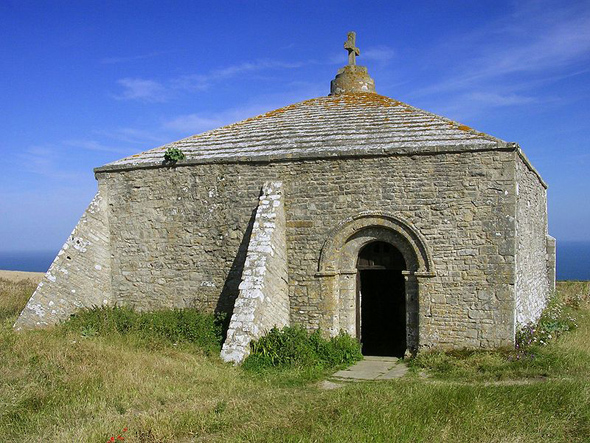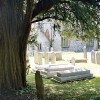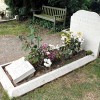It would not be an exaggeration to say that Dorset played an irreplaceable part in overcoming the Nazi threat in the 1940’s, and in the preservation of freedom for the world. Not far from Corfe Castle, where for centuries events were played out which are part of our history, on the seaward side of the Isle of Purbeck is where for two years the sciences behind electronic defence, attack and navigation were worked out.
Today, through radio technology we can watch events on the other side of the world as they happen, and view missions to the moon or Mars, and it can all be traced back to Worth Matravers and St.Aldhelm’s Head, on the Dorset coast, not forgetting earlier as well as later research locations elsewhere. Four miles from Swanage, in the early days of the Second World War, a vast radar experimental complex was set up, which was to draw Service and scientific personnel and leading electronic engineers from all parts of Britain. The inventors moved in, academics mixed with mechanics – and it was all hushed up.
From their researches came, perhaps most notably, blind bombing by an amazing new system code-named ‘H2S.’ Later, the Aircraft to Surface Vessel technique was developed to pinpoint U-boats as they hunted in packs for shipping from North America carrying the vital supplies which kept Britain going – one of the greatest threats to our survival – as well as armaments for D-Day and the conquest of continental Europe.
Even the microwave oven owes much to the Isle of Purbeck, although the idea of the cavity magnetron, which was to be used in wartime as a transmitting valve creating echoes, came from two research workers at Birmingham University – John Randall and Harry Boot. Fundamentally, they were the ones who made Worth Matravers famous. Some would say the magnetron won the war.
Microwave links for telecommunications and television have much to thank Dorset for. So have weather forecasting by radar, and navigational aids. Computers came later. Long before the war, though, with Hitler seeking world domination, defence strategies involving radar began to be developed from the mid-1930’s and a chain of early warning stations with tall masts was built all down the east coast and as far west as the Isle of Wight.
With the research station established, the small airfield at Christchurch further along the coast towards Southampton was in use for 18 months by aircraft testing the devices. The aim was to create equipment that would show echoes from the ground or from the sea aboard Allied ‘planes. Sometimes a target aircraft would fly above Swanage Bay, towards or in line with the coast so that its image could be picked up on a screen on the shore.
Reg Batt, in his book ‘The Radar Army,’ relates how echoes were first received at Worth Matravers from a coastguard hut and the chapel of St.Aldhelm, on the headland. The old chapel is now the only vestige of the research station that still exists.
But a moving target was required, so one day he set out along the headland on his bicycle, apparently on his own initiative, with a sheet of metal wired to his machine. This was to lead to exciting results on the screen. They were getting somewhere. But their big task was to reduce the wavelength they used to a few centimetres for clarity, which had never been done before, and to site the equipment they invented aboard an aircraft.
The best brains from the universities, including (Sir) Bernard Lovell, later the inventor of the Jodrell Bank radio telescope, were brought in to get the best results. All this led to the perfection of radio beams and blind bombing with the use of the magnetron valve, so that darkness or poor visibility presented no problem at all in marking the target.
Not only ‘H2S.’ but other techniques such as OBOE and GEE were developed in Dorset too. All were vital to defence, navigation and attack. Secret experiments were made with crystal and klystron, where Britain co-operated with the United States, and which was a pulse transmitter of less power than the magnetron. High-powered parties from London and abroad visited the site.
Eventually 17th century Leeson House in Swanage was to be taken over by the research station, which was an easy target with its high masts that could be sighted far out to sea. The position was very advantageous, however, and there was great excitement when distant points such as the Needles and St.Catherine’s Head, 32 miles away, were picked up.
Meanwhile, manufacturers across the country were ready to put the new creations into large-scale production for installation. Giant aerial systems involving dishes looked out on Swanage Bay, a factory production unit sprouted in north Bournemouth, and then came the day when Telecommunications Flying Unit at Christchurch was promoted and moved to a new airfield at Hurn, which was one day to become Bournemouth Airport.
In early 1942 the whole of the Worth Matravers complex moved in to Malvern College, as it was assumed to be under possible threat from commando attack. Defford Airfield in Worcestershire became the associated flying unit housing a large number of test aircraft.
It meant an upheaval for 800 personnel and in some cases their families. The seaside town of Swanage, where many of them had lived, became a quiet Dorset community once again. Masts had to be dismantled and crates packed and as many as 90 removal vans and flatbed trucks would be on the move out of the Isle of Purbeck in one day. As for the workers, they packed their things and left in fleets of coaches brought from all over the area. The move was accomplished in three weeks.
Some of the aircraft flying out of Defford, which included heavy bombers such as Lancasters, Halifaxes and Super-Fortresses, were quick to pick up echoes from the shores of the Bristol Channel, Chepstow and the River Wye. The nearest large towns of Gloucester and Cheltenham were seen almost as on a map. Meanwhile, down below, as in Dorset, the people went about their business completely ignorant of the experiments being conducted in the skies above them.
A terrible tragedy struck in June 1942, when a Halifax heavy bomber crashed in flames in the Forest of Dean, carrying all 11 RAF and scientific personnel on board to their deaths, including A.D. Blumlein, who has been called the foremost electronic engineer in Britain at that time, and who advised the type of television system adopted by the BBC in 1936 rather than the Baird system.
Prime Minister (Sir) Winston Churchill immediately ordered a redoubling of efforts on ‘H2S’ research, and some three years after the principle was discovered the cavity magnetron was installed in many of the RAF’s aircraft by the following year, as well as in U.S. Air Force aircraft. The national radar memorial window was erected in Goodrich Castle, two miles from the Halifax crash scene, in the 1990’s.
While it functioned in close association with Worth Matravers, the airfield at Christchurch, whose runway was only just long enough for the Boeing airliner shipped over from the United States, and which had been adapted as a flying test bed, was Top Secret and had its own uniformed Air Ministry police force.
What a change, and what an upheaval, came over these sedate Dorset towns (although Christchurch was then in Hampshire,) in the early years of the war; then the busy scene changed and the action moved elsewhere. Working conditions were often primitive and without heating.
Yet everyone pulled together, no secrets appear to have been divulged, and in a few years the war had been won, on the Continent, in the Atlantic, in Africa and the Far East. It is difficult to see how it could have been without radar, in which Britain took the world lead. Without that, and the part that Dorset played, world history would be very different from what we know today.





